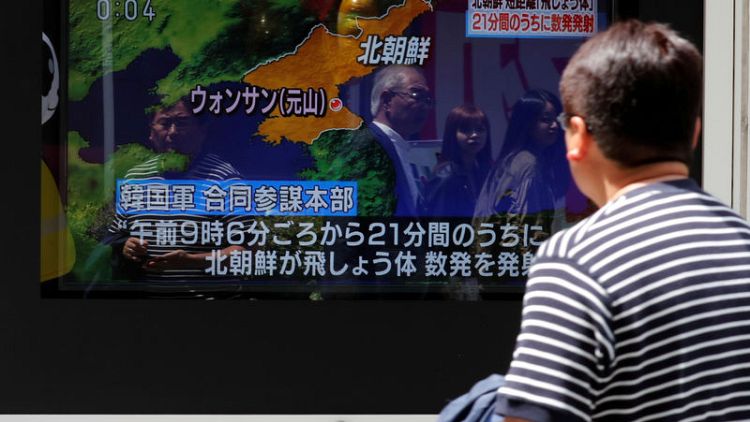By Tim Kelly
TOKYO (Reuters) - Additional tests may add at least $500 million (£405.5 million) to Japan's price tag for two U.S.-built ballistic missile interceptor stations that could struggle to shoot down the latest North Korean missile types, four government and defence sources said.
The tests are required to show the system is working properly, according to Lockheed Martin, the manufacturer. Held in Hawaii rather than Japan, they would cost about $100 million per launch.
"Japan is waiting to hear back from the U.S. Missile Defense Agency about what tests will be required," said one of the sources. "Those tests haven't been budgeted for."
As part of a major defence upgrade, Japan in 2018 agreed to buy the land-based Aegis Ashore sites offered by Washington, rejecting a new U.S. Navy radar offered by Raytheon Co <RTN.N> in favour of one designed by rival Lockheed Martin Corp <LMT.N>.
The Japanese defence minister at the time, Itsunori Onodera, did not know Japan would also have to pay for missile launches to test the Lockheed radar, the sources said. One of the defence sources said the Japanese government had thought computer-simulated tests would be sufficient.
All four asked not to be identified because they are not authorised to talk to the media.
An official at Onodera's parliamentary office declined a request to interview the senior ruling party lawmaker about the issue. It is unclear whether other Japanese officials knew about the tests.
"That topic would have been addressed in government-to-government discussions," said Lockheed Martin spokeswoman Mona Neuhass. "Regardless of the radar selected, a live fire test will be required to verify the fire-control loop."
Japan's Ministry of Defence said it had no immediate comment.
The Japanese government, among the top three foreign buyers of U.S. military hardware for the past three years, must now explain additional spending on a multibillion-dollar project.
The contract for the Aegis Ashore systems has not yet been signed. The systems are scheduled to be operational by 2024.
"It may be an opportunity for Japan to rethink Aegis Ashore in favour of integrated air missile defence," said one of the sources, who is familiar with Japan's military planning.
Integrated air missile defence (IAMD) is a broader approach to defence, with multiple components to counter threats ranging from warheads plunging from space to lower-altitude attacks such as cruise missiles.
This year, North Korea tested ballistic missiles whose warheads appeared to manoeuvre in flight, making them harder to shoot down.
Lockheed Martin referred requests to comment on new North Korean missiles to Japan's Ministry of Defense and the Missile Defense Agency.
So far Japan has budgeted $1.2 billion for Aegis Ashore hardware but expects other costs, including construction, maintenance and operational expenses over three decades to put the final tally for two sites at $4.31 billion.
Hiranao Honda, a lawmaker with the opposition Constitutional Democratic Party of Japan and director of its security division, said the additional costs showed the programme should be shut down.
"There are a series of costs that have yet to be budgeted for, such as construction, and we still have to pay for the missiles. There has not been an adequate explanation from the government," said Honda, who has requested more details from the defence ministry on Aegis Ashore costs.
He noted that Japan already had eight warships with a similar but less-capable Aegis system that can attack incoming missiles.
ALARM
A recent series of short-range missile tests by Pyongyang, which U.S. President Donald Trump dismissed as unimportant, have prompted alarm in Japan.
Former defence chief Takeshi Iwaya said last month that those launches appeared to test new missiles with irregular trajectories designed to penetrate ballistic missile defences, including the Aegis Ashore stations. Typically, such defence systems are designed to counter projectiles on predictable flight paths.
Both Lockheed Martin's Solid-State Radar and Raytheon's SPY-6, which the U.S. Navy is putting in its latest Aegis-equipped ships, promise a major boost to Aegis's ability to detect and hit incoming targets.
Japan will also have to buy interceptor missiles along with the radar. The latest missile for the Aegis system, the SM-3 Block IIA, jointly developed by Japan's Mitsubishi Heavy Industries <7011.T> and Raytheon, cost about $30 million each.
Using some of those missiles for tests would add to the cost of setting up the system, as would paying for targets that mimic incoming warheads.
TESTS OVERSEAS
Holding those tests in Japan could crank up tensions in East Asia, so Tokyo would conduct them at a more isolated test site in Hawaii, according to three of the sources.
Japan would have to pay for a temporary Aegis Ashore site there as well as interceptors, including the pricey Block IIA, which would be destroyed in any test.
Aside from personnel and target missiles, Japan would also pay for an exclusion zone to keep commercial shipping and aircraft away from the tests.
One test could cost about $100 million, according to one of the sources, who has knowledge of past tests conducted by the United States in Hawaii.
Configuring Aegis Ashore to fire other interceptors that could target newer North Korean would require additional tests, he added.
(Reporting by Tim Kelly. Editing by Gerry Doyle)
